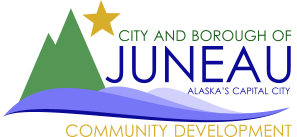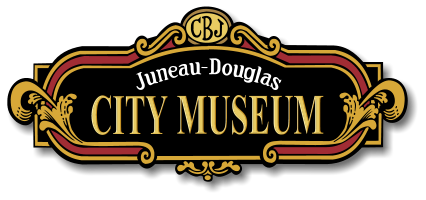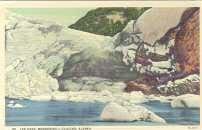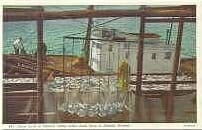History of Juneau
The Founding of Juneau, Alaska
by Nancy Warren Ferrell
For the most part, the vast spruce covered mountains and protected waterways along Gastineau Channel in Southeastern Alaska laid untouched to the mid 1800s. Before that, Tlingit Indian tribes fished the rich salmon routes for centuries. And a few well-known explorers had come before: Men such as George Vancouver and John Muir.
But it was rumors of gold that lured prospectors to the Gastineau Channel in the 1870s. Sandwiched in quartz within these coastal mountains, ran a 100-mile belt of gold from Windham Bay to Berners Bay1. River gravel below the peaks sparkled with yellow particles washed down from the mountain lodes.
A German-born mining engineer, George Pilz, then working in the headquarters of the Territory–Sitka–grubstaked prospectors to search for gold and silver 2 in Southeastern. Pilz offered substantial rewards to the local Indians(“100 pair of Hudson’s Bay blankets, and work for the tribe . . . “) 3 for any promising gold-bearing ore. When Chief Cowee of the Auk Tlingits brought in rich ore samples, Pilz sent out a party of miners to follow-up on the hopeful location. The party consisted of Joe Juneau and Richard Harris. They left Sitka in the summer of 1880.4
The two prospectors, with an Indian guide showing the way, located gold in Silver Bow Basin, on a stream they simply called Gold Creek.5 “We followed the gulch down from the summit of the mountain into the basin,” Harris later said, “and it was a beautiful sight to see the large pieces of quartz, spangled over with gold.” 6 This find was the first major Alaskan gold discovery.7
A day after the discovery–October 4, 1880–the miners wrote a “Code of Local Laws,” and staked the mining discovery. Since it was likely Joe Juneau could not read or write English,(8) Harris acted as recorder for the new town. On October 18–Alaska Day–the men blocked out a 160-acre townsite on the beach. The new mining district Harris named after himself –Harrisburgh.9
When the discovery became news, the U.S. Navy sent a steam launch to the Gastineau Channel area with the first small party of stampeders.10 The Navy detachment was sent to keep order in the mining camp,11 and was under command of Lt. Com. Charles Rockwell. A month later, Christmas of 1880, 30 miners populated the area.12 The men feasted on clam soup, “Stikeen” pot pie, and stuffed porcupine 13 that first Christmas dinner.
One of the first town meetings was held in February 1881. It was then decided that since there were so many cities in America called Harrisburgh, the town name would be changed to honor the Navy commander.14 Thus, “Rockwell” became the new name. However, by the end of 1881, Joe Juneau was complaining that nothing in the district had been named for him.15 Because he lobbied enough support from the miners, they changed the name of the town to Juneau, as it remains today.
During that first year, the area grew. A number of general stores sprang up, China Joe started a bakery, a blacksmith shop and a drug store went into operation, plus several saloon doors swung open. Indians from surrounding tribes were attracted to the mining district, too. By May 1881 alone, an estimated 450 Indians and 150 whites populated the town.16
Juneau grew steadily as the years went by. When many of the gold streams played out for the individual prospectors after a few seasons, mining and milling companies took over.
Not long after the Juneau discovery, gold was found across the channel on Douglas Island in December 17, 1880.17 French Canadian Pierre Erussard staked a rich ledge of quartz in May of 1881 on Douglas. From that discovery, and others, grew the famous Treadwell mines of the future.18
Copyright © 1995 Nancy Ferrell
A Short History of Juneau
From the Juneau Convention & Visitors Bureau 1999 Visitors Guide.
Used by permission.
Originally fishing grounds for local Tlingit Indians, the Gastineau Channel area became a focus of attention in the late 1800 ‘s when a Tlingit named Kowee of the Auk Tlingit Tribe provided gold ore samples in response to a reward offered by George Pilz, a Sitka engineer. Pilz grubstaked prospectors Richard Harris and Joseph Juneau in August 1880. They found plenty of color in Gold Creek, but did not follow the gold to its source. At Kowee ‘s urging, Pilz sent the pair back again. Harris and Juneau climbed Snow Slide Gulch at the head of Gold Creek and looked down into the mother lode of Quartz Gulch and Silver Bow Basin.
On October 18, they staked a 160 acre town site on the beach where, the following month, they were joined by the first boatloads of prospectors bound for the new strike on Gastineau Channel. The stampede was on. The discovery was the first that resulted in the founding of an Alaskan town.
Juneau grew from a boomtown to a center for large-scale hard-rock mining when the loose gold in the stream beds ran out. On the mainland side of the Channel, two great mills were created: the Alaska-Juneau at the south end of Juneau and the Alaska-Gastineau at Thane, farther south. On Douglas Island, the ground reverberated with 960 stamps of the world-renowned Treadwell Gold Mining Company.
Treadwell production peaked in 1915. Two years later, a cave-in flooded three of the four mines, effectively ending the Treadwell era. In Juneau, the Alaska-Gastineau folded from high costs in 1921. A-J was halted by the war in 1944.
Juneau was established as Alaska ‘s capital in 1906 when the government was transferred from Sitka. Today, federal, state and local government employs one out of every two Juneau workers. Tourism is the largest private employer and continues to grow. Commercial fishing and mining continue to play a role in Juneau ‘s economy.
Please see Nancy Warren Ferrell’s History of the Founding of Juneau
An Outline History of Juneau Municipal Government
- In 1881, the Committee on Town Laws voted for a new name for the town of Juneau. “Juneau City” won the vote overruling “Harrisburg” and “Rockwell.” In 1882, the change was officially made by the U.S. Post Office Department, which dropped the word “City” making the official name “Juneau.”
- The City of Juneau was incorporated and became Alaska’s state capital in 1900.
- In 1881, the town of Douglas was established as a mining community. Prior to that time, Douglas had also been referred to as “Edwardsville,” presumably after an early resident and miner H.H. Edwards.
- The “City of Douglas” was incorporated in 1902.
In the transition from territory to statehood and in accordance with provisions of the 1959 Session Laws of the State of Alaska the City of Juneau was established as a home-rule city in October 1960.
- A Manager-Council form of government was established. The Council had seven members with the Mayor as presiding officer.
- The boundaries of the new City of Juneau remained as previously drawn.
The Greater Juneau Borough was incorporated as a first class borough on September 30, 1963.
- The form of government established included a nine-member Assembly with a President as presiding officer and an Assembly-elected administrator. Representation on the Assembly was composed of three members from the City of Juneau, one member from the City of Douglas, and five members from outside the cities of Juneau and Douglas.
- The boundaries of the Greater Juneau Borough included Holkham Bay in Stephens Passage; the Alaska-Canadian Boundary Line encompassing Peak Nos. 79 and 98 of the Ice Field; Eldred Rock Light; Lincoln Island; Point Young; Point Arden Light:, Midway Island Light; and Point Coke.
The City of Douglas was established as a home-rule city in October 1966.
- The City of Douglas Council consisted of six Councilmen and the Mayor.
- Boundaries of the City of Douglas remained as previously established.
The City and Borough of Juneau was incorporated as a unified City and Borough on July 1, 1970.
- The City and Borough of Juneau Assembly has nine members with the Mayor as presiding officer. It is a strong Manager form of government.
- The newly created boundaries of the City and Borough of Juneau consolidated the City of Douglas, the City of Juneau. and the Greater Juneau Borough.
- The City and Borough of Juneau is a home-rule municipality, exercising the powers granted to it by the Constitution of the State of Alaska, As part of its preamble to the Charter, the City and Borough of Juneau’s mission is to “provide for local government responsive to the will of the people and to the continuing needs of the community.”
By Marian Miller, former Municipal Clerk
First published on this web site June 9, 1997
- Arthur K. Delaney = 1900-1901
- George F. Forrest = 1901-1902
- O. H. Adsit = 1902-1904
- George F. Forrest = 1904-1905
- John F. Maloney = 1905-1906
- Herman T. Tripp = 1906-1907
- George F. Forrest = 1907-1908
- Emery Valentine = 1908-1912
- Harry A. Bishop = 1912-1913
- Charles W. Carter = 1913-1914
- John Reck = 1914-1916
- B. D. Stewart = 1916-1917
- Emery Valentine = 1917-1919
- J. Latimer Gray = 1919-1920
- R. E. Robertson = 1920-1923
- I. Goldstein = 1923-1925
- J. J. Connors = 1925-1927
- Thomas B. Judson = 1927-1933
- I. Goldstein = 1933-1937
- Thomas B. Judson = 1937-1938
- Harry I. Lucas = 1938-1944
- A. B.”Cot” Hayes = 1944-1945
- Ernest Parsons = 1945-1946
- Waino Hendrickson = 1946-1953
- Bert F. McDowell = 1953-1955
- M. L. MacSpadden = 1955-1959
- Lauris S. Parker = 1959-1961
- J. Wayne Johnson = 1961*
- A. W. Boddy = 1961-October, 1961*
- Lauris S. Parker = 1961-1967
- Timothy O’Day = 1967
- Joseph George = 1967-1969
- Joseph A. McLean = 1969-1973
- William A Macomber = 1973-1975
- Virginia Kline/Chitwood = 1975-1976
- W.D. ‘Bill’ Overstreet = 1976-1983
- Fran Ulmer = 1983-1985
- Ernest E. Polley = 1985-1988
- Bruce Botelho = 1988-1991
- Jamie Parsons = 1991-1994
- Byron Mallott = October 1994-February, 1995
- Dennis Egan = February 1995- October 2000
- Sally Smith = October 2000 – 2003
- Bruce Botelho = 2003 – 2012
- Merrill Sanford = 2012 – Present





